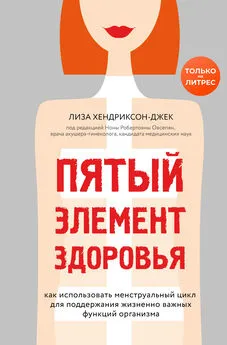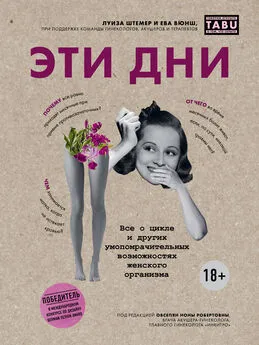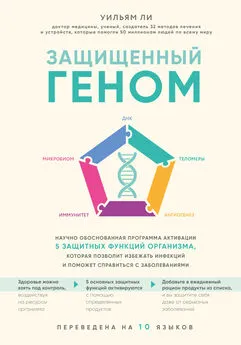Лиза Хендриксон-Джек - Пятый элемент здоровья. Как использовать менструальный цикл для поддержания жизненно важных функций организма
- Название:Пятый элемент здоровья. Как использовать менструальный цикл для поддержания жизненно важных функций организма
- Автор:
- Жанр:
- Издательство:Литагент 5 редакция
- Год:2020
- Город:Москва
- ISBN:978-5-04-104425-1
- Рейтинг:
- Избранное:Добавить в избранное
-
Отзывы:
-
Ваша оценка:
Лиза Хендриксон-Джек - Пятый элемент здоровья. Как использовать менструальный цикл для поддержания жизненно важных функций организма краткое содержание
«Почти» – потому что у женщин есть пятый показатель здоровья, на который, к сожалению, все еще мало кто обращает внимание, – это менструальный цикл. Короткий или длинный, регулярный или непредсказуемый – цикл может быть очень разным, и каждый его параметр, каждое изменение служат индикатором той или иной проблемы в организме. Планируете вы беременность или нет, овуляция имеет значение для поддержания здоровья.
Автор этой книги расскажет, что именно влияет на состояние менструального цикла, и научит вас составлять его график для максимально точного и удобного отслеживания различных изменений и контроля здоровья.
Пятый элемент здоровья. Как использовать менструальный цикл для поддержания жизненно важных функций организма - читать онлайн бесплатно ознакомительный отрывок
Интервал:
Закладка:
14. Drake, C., T. Roehrs, J. Shambroom, and T. Roth. “Caffeine effects on sleep taken 0, 3, or 6 hours before going to bed.” Journal of Clinical Sleep Medicine 9, no. 11 (2013): 1195-1200.
15. Landolt, Hans-Peter, Esther Werth, Alexander A. Borbély, and Derk-Jan Dijk. “Caffeine intake (200 mg) in the morning affects human sleep and EEG power spectra at night.” Brain Research 675, no. 1 (1995): 67–74.
16. Lee, Bruce Y., Patrick J. LaRiccia, and Andrew B. Newberg. “Acupuncture in theory and practice part 1: theoretical basis and physiologic effects.” Hospital Physician 40, no. 4 (2004): 11-18.
17. Yang, Pei-Yu, Ka-Hou Ho, Hsi-Chung Chen, and Meng-Yueh Chien. “Exercise training improves sleep quality in middle-aged and older adults with sleep problems: a systematic review.” Journal of Physiotherapy 58, no. 3 (2012): 157–163; Reid, Kathryn J., Kelly Glazer Baron, Brandon Lu, Erik Naylor, Lisa Wolfe, and Phyllis C. Zee. “Aerobic exercise improves self-reported sleep and quality of life in older adults with insomnia.” Sleep Medicine 11, no. 9 (2010): 934–940; Youngstedt, Shawn D., and Christopher E. Kline. “Epidemiology of exercise and sleep.” Sleep and Biological Rhythms 4, no. 3 (2006): 215–221.
18. Myllymäki, Tero, Heikki Kyröläinen, Katri Savolainen, Laura Hokka, Riikka Jakonen, Tanja Juuti, Kaisu Martinmäki, Jukka Kaartinen, Marja-Liisa Kinnunen, and Heikki Rusko. “Effects of vigorous late-night exercise on sleep quality and cardiac autonomic activity.” Journal of Sleep Research 20, no. 1pt2 (2011): 146–153; Yoshida, Hironori, Tohru Ishikawa, Fumio Shiraishi, and Toshinori Kobayashi. “Effects of the timing of exercise on the night sleep.” Psychiatry and Clinical Neurosciences 52, no. 2 (1998): 139–140.
19 Khodr, Amy, Caroline Awada, Massoot Mohammed, and Reabal Najjar. “Bump and sleep: how sexual intercouse can improve sleep of women with insomnia.” Accessed August 18, 2017. ruor.uottawa.ca/handle/10393/35554?mode=full.
20. Singleton, David W., and Sohaib A. Khan. “Xenoestrogen exposure and mechanisms of endocrine disruption.” Frontiers in Bioscience 8 (2003): s110–s118.
21. Gore, A.C., D. Crews, L.L. Doan, M. La Merrill, H. Patisaul, and A. Zota. “Introduction to endocrine disrupting chemicals (EDCs) – a guide for public interest organizations and policy makers.” Endocrine Society Reports and White Papers 1 (2014): 1–69.
22. “Recent Trends in GE Adoption.” Accessed August 22, 2017. www.ers.usda.gov/data-products/adoption-of-genetically-engineered-crops-in-the-us/recent-trends-in-ge-adoption.aspx.
23. USDA Food Safety and Inspection Service. “FSIS.” Accessed September 10, 2018. www.fsis.usda.gov/wps/portal/fsis/topics/food-safety-ducation/get-answers/food-safety-fact-sheets/meat-preparation/beef-from-farm-to-table; Health Canada. “Questions and Answers – Hormonal Growth Promoters.” Accessed September 10, 2018. www.canada.ca/en/health-canada/services/drugs-health-products/veterinary-drugs/factsheets-faq/hormonal-growth-promoters.html.
24. Health Canada. “Questions and Answers – Hormonal Growth Promoters.” Accessed September 10, 2018. www.canada.ca/en/health-canada/services/drugs-health-products/veterinary-drugs/factsheets-faq/hormonal-growth– promoters.html; Social Protection Statistics – Unemployment Benefits – Statistics Explained. “Hormones in Meat – Food Safety – European Commission.” Accessed September 10, 2018. ec.europa.eu/food/safety/chemical_safety/meat_hormones_en.
25. Mnif, Wissem, Aziza Ibn Hadj Hassine, Aicha Bouaziz, Aghleb Bartegi, Olivier Thomas, and Benoit Roig. “Effect of endocrine disruptor pesticides: a review.” International Journal of Environmental Research and Public Health 8, no. 6 (2011): 2265–2303.
26. Benbrook, Charles M. “Trends in glyphosate herbicide use in the United States and globally.” Environmental Sciences Europe 28, no. 1 (2016): 1–15.
27. Monsanto International S.A.R.L. and Monsanto Europe S.A. “The agronomic benefits of glyphosate in Europe: review of the benefits of glyphosate per market use.” Review (2010): 1–82.
28. Darwent, A.L., K.J. Kirkland, L. Townley-Smith, K.N. Harker, A.J. Cessna, O.M. Lukow, and L.P. Lefkovitch. “Effect of preharvest applications of glyphosate on the drying, yield and quality of wheat.” Canadian Journal of Plant Science 74, no. 2 (1994): 221–230.
29. Samsel, Anthony, and Stephanie Seneff. “Glyphosate, pathways to modern diseases II: Celiac sprue and gluten intolerance.” Interdisciplinary Toxicology 6, no. 4 (2013): 159–184.
30. Bøhn, Thomas, Marek Cuhra, Terje Traavik, Monica Sanden, J. Fagan, and R. Primicerio. “Compositional differences in soybeans on the market: glyphosate accumulates in Roundup Ready GM soybeans.” Food Chemistry 153 (2014): 207–215.
31. “EWG.” Accessed March 30, 2018. www.ewg.org.
32. Center for Food Safety and Applied Nutrition. “Ingredients – Phthalates.” US Food and Drug Administration Home Page. Accessed August 21, 2017. www.fda.gov/cosmetics/productsingredients/ingredients/ucm128250.htm.
33. Chen, Xueping, Shisan Xu, Tianfeng Tan, Sin Ting Lee, Shuk Han Cheng, Fred Wang Fat Lee, Steven Jing Liang Xu, and Kin Chung Ho. “Toxicity and estrogenic endocrine disrupting activity of phthalates and their mixtures.” International Journal of Environmental Research and Public Health 11, no. 3 (2014): 3156–3168.
34. Parlett, Lauren E., Antonia M. Calafat, and Shanna H. Swan. “Women’s exposure to phthalates in relation to use of personal care products.” Journal of Exposure Science & Environmental Epidemiology 23, no. 2 (2013): 197–206.
35. USDA. “Adoption of Genetically Engineered Crops in the US.” Accessed August 21, 2017. www.ers.usda.gov/data-products/adoption-of-genetically-engineered-crops-in-the-us.aspx.
36. Biotech Country Facts and Trends – ISAAA Publications. “Biotech Country Facts and Trends – India.” Accessed August 21, 2017. www.isaaa.org/resources/publications/biotech_country_facts_and_trends/download/Facts%20and%20Trends%20-%20India.pdf.
37. US Food and Drug Administration Home Page. “Women’s Health Research – Dioxin in Tampons.” Accessed August 21, 2017. www.fda.gov/scienceresearch/specialtopics/womenshealthresearch/ucm134825.htm
38. Gibson, Douglas A., and Philippa T.K. Saunders. “Endocrine disruption of oestrogen action and female reproductive tract cancers.” Endocrine-Related Cancer 21, no. 2 (2014): T13–T31; Hutz, R.J., M.J. Carvan III, J.K. Larson, Q. Liu, R.V. Stelzer, T.C. King-Heiden, M.G. Baldridge, N. Shahnoor, and K. Julien. “Familiar and novel reproductive endocrine disruptors: xenoestrogens, dioxins and nanoparticles.” Current Trends in Endocrinology 7 (2014): 111–122; Marshall, Nikki B., and Nancy I. Kerkvliet. “Dioxin and immune regulation.” Annals of the New York Academy of Sciences 1183, no. 1 (2010): 25–37; Hutz, R.J., M.J. Carvan, M.G. Baldridge, L.K. Conley, and T.K. Heiden. “Environmental toxicants and effects on female reproductive function.” Trends in Reproductive Biology 2 (2006): 1–11.
39. Hutz, R.J., M.J. Carvan, M.G. Baldridge, L.K. Conley, and T.K. Heiden. “Environmental toxicants and effects on female reproductive function.” Trends in Reproductive Biology 2 (2006): 1–11.
40. Alonso-Magdalena, Paloma, Ana Belén Ropero, Sergi Soriano, Marta García-Arévalo, Cristina Ripoll, Esther Fuentes, Iván Quesada, and Ángel Nadal. “Bisphenol-A acts as a potent estrogen via non-classical estrogen triggered pathways.” Molecular and Cellular Endocrinology 355, no. 2 (2012): 201–207; Mileva, Guergana, Stephanie L. Baker, Anne Konkle, and Catherine Bielajew. “Bisphenol-A: epigenetic reprogramming and effects on reproduction and behavior.” International Journal of Environmental Research and Public Health 11, no. 7 (2014): 7537-7561; Richter, Catherine A., Linda S. Birnbaum, Francesca Farabollini, Retha R. Newbold, Beverly S. Rubin, Chris E. Talsness, John G. Vandenbergh, Debby R. Walser– Kuntz, and Frederick S. vom Saal. “In vivo effects of bisphenol A in laboratory rodent studies.” Reproductive Toxicology 24, no. 2 (2007): 199-224; Caserta, Donatella, Noemi Di Segni, Maddalena Mallozzi, Valentina Giovanale, Alberto Mantovani, Roberto Marci, and Massimo Moscarini. “Bisphenol A and the female reproductive tract: an overview of recent laboratory evidence and epidemiological studies.” Reproductive Biology and Endocrinology 12 (2014): 12–37.
41. Kandaraki, Eleni, Antonis Chatzigeorgiou, Sarantis Livadas, Eleni Palioura, Frangiscos Economou, Michael Koutsilieris, Sotiria Palimeri, Dimitrios Panidis, and Evanthia Diamanti-Kandarakis. “Endocrine disruptors and polycystic ovary syndrome (PCOS): elevated serum levels of bisphenol A in women with PCOS.” The Journal of Clinical Endocrinology & Metabolism 96, no. 3 (2010): E480–E484; Cobellis, Luigi, Nicola Colacurci, Elisabetta Trabucco, Carmen Carpentiero, and Lucia Grumetto. “Measurement of bisphenol A and bisphenol B levels in human blood sera from healthy and endometriotic women.” Biomedical Chromatography 23, no. 11 (2009): 1186–1190; Signorile, Pietro G., Enrico P. Spugnini, Luigi Mita, Pasquale Mellone, Alfredo D’Avino, Mariangela Bianco, Nadia Diano et al. “Prenatal exposure of mice to bisphenol A elicits an endometriosis-like phenotype in female offspring.” General and Comparative Endocrinology 168, no. 3 (2010): 318–325; Bhan, Arunoday, Imran Hussain, Khairul I. Ansari, Samara AM Bobzean, Linda I. Perrotti, and Subhrangsu S. Mandal. “Bisphenol-A and diethylstilbestrol exposure induces the expression of breast cancer associated long noncoding RNA HOTAIR in vitro and in vivo.” The Journal of Steroid Biochemistry and Molecular Biology 141 (2014): 160–170.
42. Vandenberg, Laura N., Maricel V. Maffini, Carlos Sonnenschein, Beverly S. Rubin, and Ana M. Soto. “Bisphenol-A and the great divide: a review of controversies in the field of endocrine disruption.” Endocrine Reviews 30, no. 1 (2009): 75–95.
43. Cao, X–L., C. Perez-Locas, G. Dufresne, G. Clement, S. Popovic, F. Beraldin, R. W. Dabeka, and M. Feeley. “Concentrations of bisphenol A in the composite food samples from the 2008 Canadian total diet study in Quebec City and dietary intake estimates.” Food Additives and Contaminants 28, no. 6 (2011): 791–798; Liao, Chunyang, and Kurunthachalam Kannan. “Widespread occurrence of bisphenol A in paper and paper products: implications for human exposure.” Environmental Science & Technology 45, no. 21 (2011): 9372–9379; Wang, Wei, Khalid O. Abualnaja, Alexandros G. Asimakopoulos, Adrian Covaci, Bondi Gevao, Boris Johnson-Restrepo, Taha A. Kumosani et al. “A comparative assessment of human exposure to tetrabromobisphenol A and eight bisphenols including bisphenol A via indoor dust ingestion in twelve countries.” Environment International 83 (2015): 183–191.
44. Biegel, Lisa B., Raymond CM Liu, Mark E. Hurtt, and Jon C. Cook. “Effects of ammonium perfluorooctanoate on Leydig-cell function: in vitro, in vivo, and ex vivo studies.” Toxicology and Applied Pharmacology 134, no. 1 (1995): 18–25; Shi, Zhimin, Hongxia Zhang, Yang Liu, Muqi Xu, and Jiayin Dai. “Alterations in gene expression and testosterone synthesis in the testes of male rats exposed to perfluorododecanoic acid.” Toxicological Sciences 98, no. 1 (2007): 206–215; Wei, Yanhong, Jiayin Dai, Min Liu, Jianshe Wang, Muqi Xu, Jinmiao Zha, and Zijian Wang. “Estrogen-like properties of perfluorooctanoic acid as revealed by expressing hepatic estrogen-responsive genes in rare minnows (Gobiocypris rarus).” Environmental Toxicology and Chemistry 26, no. 11 (2007): 2440–2447; White, Sally S., Suzanne E. Fenton, and Erin P. Hines. “Endocrine disrupting properties of perfluorooctanoic acid.” The Journal of Steroid Biochemistry and Molecular Biology 127, no. 1 (2011): 16–26.
Читать дальшеИнтервал:
Закладка:









